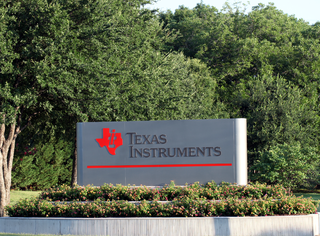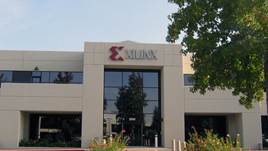
Texas Instruments Inc. (TI) is an American technology company that designs and manufactures semiconductors and various integrated circuits, which it sells to electronics designers and manufacturers globally. Its headquarters are in Dallas, Texas, United States. TI is one of the top ten semiconductor companies worldwide, based on sales volume. Texas Instruments's focus is on developing analog chips and embedded processors, which accounts for more than 80% of their revenue. TI also produces TI digital light processing (DLP) technology and education technology products including calculators, microcontrollers and multi-core processors. To date, TI has more than 43,000 patents worldwide.
Synopsys is an American company. Synopsys' first and best-known product is Design Compiler, a logic-synthesis tool. Synopsys offers a wide range of other products used in the design of an application-specific integrated circuit. Products include logic synthesis, behavioral synthesis, place and route, static timing analysis, formal verification, hardware description language simulators as well as transistor-level circuit simulation. The simulators include development and debugging environments which assist in the design of the logic for chips and computer systems. In recent years Synopsys has also expanded into the application security market.

Analog Devices, Inc., also known as ADI or Analog, is an American multinational semiconductor company specializing in data conversion and signal processing technology, headquartered in Norwood, Massachusetts. In 2012, Analog Devices led the worldwide data converter market with a 48.5% share, according to analyst firm Databeans.

Xilinx, Inc. is an American technology company, primarily a supplier of programmable logic devices. It is known for inventing the field-programmable gate array (FPGA) and as the semiconductor company that created the first fabless manufacturing model.
Conexant Systems, Inc. was an American-based software developer and fabless semiconductor company. They provided products for voice and audio processing, imaging and modems. The company began as a division of Rockwell International, before being spun off as a public company. Conexant itself then spun off several business units, creating independent public companies which included Skyworks Solutions and Mindspeed Technologies.
Lexra was a semiconductor intellectual property core company based in Waltham, Massachusetts. It was founded in 1997 and began developing and licensing semiconductor intellectual property cores that implemented the MIPS I architecture, except for the four unaligned load and store instructions.
Ittiam Systems is a venture capital funded global technology company founded by ex-Managing Director of Texas Instruments' India Srini Rajam in 2001, developing multimedia solutions for End-to-End Video distribution and delivery, ranging the complete gamut from content creation to consumption. It is headquartered in Bangalore, India and has marketing offices in the United States, UK, France, Japan, China, Singapore and Taiwan.

Cadence Design Systems, Inc. is an American multinational electronic design automation (EDA) software and engineering services company, founded in 1988 by the merger of SDA Systems and ECAD, Inc. The company produces software, hardware and silicon structures for designing integrated circuits, systems on chips (SoCs) and printed circuit boards.
Imagination Technologies Group plc is a British-based technology company, focusing on semiconductor and related intellectual property licensing. It markets PowerVR mobile graphics processors, MIPS embedded microprocessors, and for its Pure consumer electronics division. It also supplies radio baseband processing, networking, digital signal processor, video and audio hardware, voice over IP software, cloud computing and silicon and system design services. The company was listed on the London Stock Exchange until it was acquired by Canyon Bridge in November 2017.
Duolog Technologies was an Irish-based company that developed electronic design automation tools that assist with the integration of complex System-on-Chip(SoC), ASIC and FPGA designs. In 2014, Duolog was acquired by ARM Holdings plc, a multinational semiconductor and software design company headquartered in Cambridge, United Kingdom.

Arm Holdings is a British multinational semiconductor and software design company, owned by SoftBank Group and its Vision Fund. With its headquarters in Cambridgeshire, within the United Kingdom, its primary business is in the design of ARM processors (CPUs), although it also designs software development tools under the DS-5, RealView and Keil brands, as well as systems and platforms, system-on-a-chip (SoC) infrastructure and software. As a "Holding" company, it also holds shares of other companies. It is considered to be market dominant for processors in mobile phones and tablet computers. The company is one of the best-known "Silicon Fen" companies.
Mindspeed Technologies, Inc. designs, develops and sells semiconductors for communications applications in wireless and wired networks. The company is a fabless semiconductor manufacturer.
Hexagon (QDSP6) is the brand for a family of 32-bit multi-threaded microarchitectures implementing the same instruction set for a digital signal processor (DSP) developed by Qualcomm. According to 2012 estimation, Qualcomm shipped 1.2 billion DSP cores inside its system on a chip (SoCs) in 2011 year, and 1.5 billion cores were planned for 2012, making the QDSP6 the most shipped architecture of DSP.
Infinity Group is a private equity fund backed by China Development Bank and Clal Industries. The head of Infinity Group is Amir Gal-Or. Infinity Group manages RMB 10 billion and 100 portfolio companies, through 17 local RMB funds throughout China.
Arteris, Inc. is a multinational technology firm that develops the on-chip interconnect fabric technology used in System-on-Chip (SoC) semiconductor designs for a variety of devices, particularly in mobile and consumer markets. The company specializes in the development and distribution of Network-on-Chip (NoC) interconnect Intellectual Property (IP) solutions. It is best known for its flagship product, Arteris FlexNoC, which is used in more than 60 percent of mobile and wireless SoC designs.

The HSA Foundation is a not-for-profit engineering organization of industry and academia that works on the development of the Heterogeneous System Architecture (HSA), a set of royalty-free computer hardware specifications, as well as open source software development tools needed to use HSA features in application software.

Adesto Technologies is an American corporation founded in 2006 and based in Santa Clara, California. The company provides application-specific semiconductors including non-volatile memory (NVM) products, as well as analog and mixed-signal ASICs and Intellectual Property (IP) cores. The company sells its products directly to original equipment manufacturers (OEMs) and original design manufacturers (ODMs) that manufacture products for its end customers.











